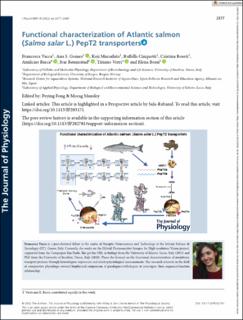| dc.contributor.author | Vacca, Francesca | |
| dc.contributor.author | Gomes, Ana S. | |
| dc.contributor.author | Murashita, Koji | |
| dc.contributor.author | Cinquetti, Raffella | |
| dc.contributor.author | Roseti, Cristina | |
| dc.contributor.author | Barca, Amilcare | |
| dc.contributor.author | Rønnestad, Ivar | |
| dc.contributor.author | Verri, Tiziano | |
| dc.contributor.author | Bossi, Elena | |
| dc.date.accessioned | 2022-12-15T08:41:38Z | |
| dc.date.available | 2022-12-15T08:41:38Z | |
| dc.date.created | 2022-06-07T18:14:46Z | |
| dc.date.issued | 2022 | |
| dc.identifier.issn | 0022-3751 | |
| dc.identifier.uri | https://hdl.handle.net/11250/3037854 | |
| dc.description.abstract | The high-affinity/low-capacity system Slc15a2 (PepT2) is responsible for the reuptake of di/tripeptides from the renal proximal tubule, but it also operates in many other tissues and organs. Information regarding PepT2 in teleost fish is limited and, to date, functional data are available from the zebrafish (Danio rerio) only. Here, we report the identification of two slc15a2 genes in the Atlantic salmon (Salmo salar) genome, namely slc15a2a and slc15a2b. The two encoded PepT2 proteins share 87% identity and resemble both structurally and functionally the canonical vertebrate PepT2 system. The mRNA tissue distribution analyses reveal a widespread distribution of slc15a2a transcripts, being more abundant in the brain and gills, while slc15a2b transcripts are mainly expressed in the kidney and the distal part of the gastrointestinal tract. The function of the two transporters was investigated by heterologous expression in Xenopus laevis oocytes and two-electrode voltage-clamp recordings of transport and presteady-state currents. Both PepT2a and PepT2b in the presence of Gly-Gln elicit pH-dependent and Na+ independent inward currents. The biophysical and kinetic analysis of the recorded currents defined the transport properties, confirming that the two Atlantic salmon PepT2 proteins behave as high-affinity/low-capacity transporters. The recent structures and the previous kinetic schemes of rat and human PepT2 qualitatively account for the characteristics of the two Atlantic salmon proteins. This study is the first to report on the functional expression of two PepT2-type transporters that operate in the same vertebrate organism as a result of (a) gene duplication process(es). | en_US |
| dc.language.iso | eng | en_US |
| dc.publisher | Wiley | en_US |
| dc.rights | Attribution-NonCommercial-NoDerivatives 4.0 Internasjonal | * |
| dc.rights.uri | http://creativecommons.org/licenses/by-nc-nd/4.0/deed.no | * |
| dc.title | Functional characterization of Atlantic salmon (Salmo salar L.) PepT2 transporters | en_US |
| dc.type | Journal article | en_US |
| dc.type | Peer reviewed | en_US |
| dc.description.version | publishedVersion | en_US |
| dc.rights.holder | Copyright 2022 the authors | en_US |
| cristin.ispublished | true | |
| cristin.fulltext | original | |
| cristin.qualitycode | 2 | |
| dc.identifier.doi | 10.1113/JP282781 | |
| dc.identifier.cristin | 2030029 | |
| dc.source.journal | Journal of Physiology | en_US |
| dc.source.pagenumber | 2377-2400 | en_US |
| dc.identifier.citation | Journal of Physiology. 2022, 600 (10), 2377-2400. | en_US |
| dc.source.volume | 600 | en_US |
| dc.source.issue | 10 | en_US |

